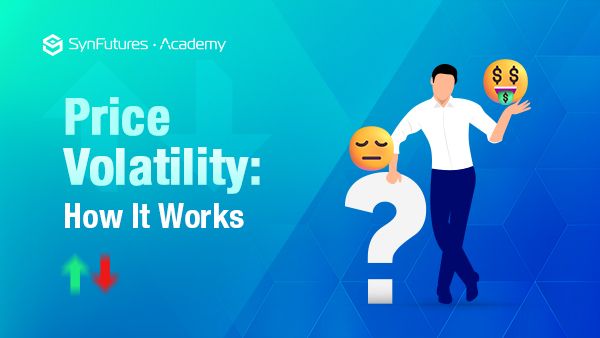Price Volatility: How It Works
Overview
Volatility refers to the degree to which the price of an underlying asset changes over a period. Volatility increases with both the sudden rise or fall in the price of the underlying asset and decreases if the price remains in a narrow range. It’s primarily used to determine the risk of investing in an asset, as more volatile assets are considered riskier than less volatile ones.
Volatility also differs widely between different asset classes. For example, currencies are less volatile, stocks are more volatile than currencies, and cryptos are even more volatile than stocks. When trading in different asset classes, it’s essential to understand its volatility before entering a trade.
Generally, as an asset class gains more acceptance and investment, its volatility will decrease. Of course, this doesn’t mean that it won’t have periods of high volatility but that the overall volatility will come down. Below is a chart showing Bitcoin volatility since 2010.
As we can see, Bitcoin was highly volatile during its early days, but the volatility continued to decrease as Bitcoin gained more acceptance and attracted more investment. As of late 2022, Bitcoin is going through the least volatile period in its history.
Types of Volatility
Volatility is mainly classified into two major types: Historical and implied volatility.
Historical Volatility: This is calculated through the price fluctuation of the underlying asset over a period, typically a year. The chart above is a historical volatility indicator that tracks Bitcoin price variation over a 30-day period for the past 12 years. As an indicator, this is backward looking as it looks at how the price behaved in the past.
Implied Volatility: This is the forward-looking forecast of how volatile the price of the underlying asset is likely to be in the coming days, weeks, or months. One thing to keep in mind is that IV does not forecast the direction of the price movement but just the extent of the price movement.
What Causes Volatility?
Volatility can be caused by several factors. It could be an event specific to cryptocurrencies, such as a major partnership announcement or a major hack. Or it could be something related to the larger market, like bad economic news, war, inflation data, and so on.
In addition to specific events, human emotion also plays a key role in increased volatility. For example, if bad news hits the market, people will start selling the coins, which will drive the price lower. As the price moves lower, more people will start to sell, which will move the price even lower, resulting in even more people selling. This starts a vicious cycle until the coin finds a strong support level. The same thing will also happen to the upside, where more people buying a coin causes the coin to increase in price, and that, in turn, results in more people buying the coin.
The fact that volatility is the combination of unexpected news and human emotion is what makes it so difficult to predict and manage.
Indicators Measuring Volatility
Since it’s such a fundamental part of trading, several indicators are specifically designed to track volatility. Some of the famous ones are:
Bollinger Band: Consists of an upper band, a lower band, and a 20-Day Moving Average line in the middle. The upper band has two standard deviations above the 20DMA, while the lower band has two standard deviations below the 20DMA.
The orange line in the middle is the 20-day moving average, and the top and bottom bands are two standard deviations above and below. As we can see from the above chart, the band narrows during periods of less volatility, like the mid-2019 to mid-2020 period, and expands rapidly during periods of high volatility, like the late-2020 to early-2021 period.
Average True Range (ATR): This is another popular indicator that is often used to measure volatility. Created by Welles Wilder Jr, ATR is calculated using the current day high, current day low, and previous day close. An increasing ATR line indicates the asset is becoming more volatile, while a decreasing ATR indicates the asset is becoming less volatile. Below is an ART indicator of Bitcoin for the same period.
Keltner Channel: Like the Bollinger band, it has an upper and lower band with a median line in between, but the main difference is how the volatility is calculated. Keltner calculates volatility using the ATR indicator, while Bollinger calculates it using standard deviation and 20DMA. Because of their similarity, there are a lot of discussions on which one better predicts the market. However, there is no consensus on that question. It’s up to the discretion of traders to choose the one that better suits their trading style. An example of the Keltner channel for the same period is shown below.
Volatility and Futures Trading
For traders, volatility should be an important metric to consider when entering any trade, and it’s even more important for Futures traders since most would be trading with leverage. Leverage allows traders to take positions that are bigger than the initial capital, ranging from 10 times to 100 times. With such high leverage, any volatile price movement could wipe out the entire capital and cause liquidation.
And liquidation is just one of the problems caused by a big spike in volatility; others include
- Decreasing liquidity: As most users close their position because of volatility, liquidity in the market dries up.
- Technical difficulties: High volatility could cause technical difficulties in some exchanges as many users place orders at the same time. Here is an example of how Binance froze during the 2021 Bitcoin crash.
Because of all these reasons, futures traders should always keep an eye on volatility during any trade.
How to Deal with Volatility
Decreasing liquidity and technical difficulties in an exchange are beyond the control of any trader. However, there are different ways to avoid getting liquidated. As a rule of thumb, taking an active risk management approach during a trade, protecting the capital, and not getting swayed by emotions are all extremely important for handling volatility and even profiting from it.
Conclusion
Despite all the negatives attached, volatility is not always bad. It is just as likely to move the market up as it is to move the market down. This means there is a chance a trader could get liquidated but also a chance that they could gain huge returns. Ultimately, dealing with volatility is one of the key qualities a person needs to learn to become a successful trader. Understanding volatility is the first step in figuring out how to deal with it. Hopefully, this article has helped you take that first step.
Discover SynFutures' Crypto Derivatives products: www.synfutures.com/.
Disclaimer: SynFutures Academy does not guarantee the reliability of the site content and shall not be held liable for any errors, omissions, or inaccuracies. The opinions and views expressed in any SynFutures Academy article are solely those of the author(s) and do not reflect the opinions of SynFutures. The SynFutures Academy articles are for educational purposes or information only. SynFutures Academy has no relationship to the projects mentioned in the articles, and there is no endorsement for these projects. The information provided on the site does not constitute an endorsement of any of the products and services discussed or investment, financial, or trading advice. A qualified professional should be consulted before making financial decisions.




